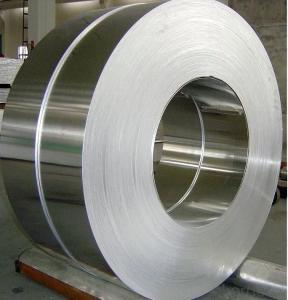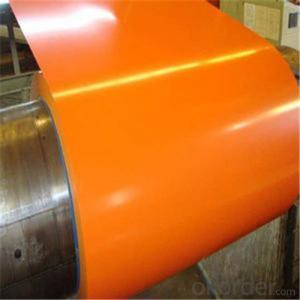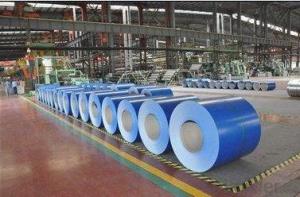Rolled Colored Galvanized Coil in Stainless Steel
- Loading Port:
- Qingdao
- Payment Terms:
- TT OR LC
- Min Order Qty:
- 25 m.t.
- Supply Capability:
- 10000 m.t./month
OKorder Service Pledge
OKorder Financial Service
You Might Also Like
Rolled Colored Galvanized Coil in Stainless Steel
Brief Introduction of Rolled Colored Coil
Color painted coils based with galvanized coils take hot-dip galvanized steel coil as its basic material.
Factory adopts the newest technologies and the most advanced equipmentsto degrease, rinse,
chemical transform the cold-rolled steel coils or galvanized steel coils. Then we make primary and
refined lavation for the steel strips.
Main Specification for Rolled Colored Coil
1) Thickness: 0.16 - 2.0mm
2) Width: 914 - 1,250mm
3) Lacquer: according to customer's needs
4) The color-coated steel coil is produced by hot-galvanized steel and color-coatedwith the
paint produced according to the American standards
5) The combining force between the galvanized steel and the paint is very strong
6) The surface is polished
7) Coat fabric 2/2 (two coats for top / two coats for bottom), 2/1 (two coats fortop / single
coat for bottom), 1/1 (single coat for top / single coat for bottom)
8) Available colors: grey, bright red, sky blue, ivory white, yellow or customizedaccording to
customers' request
9) Can be used in building material field, galvanized wire steel tape and all otherfields
10)
Base steel: DX51D ,Q195, Q215, Q235, Q345, Q195L, 08, 08AL, SPCC, SPCD, ST12, ST37, DC01, DC02 and DC03
FAQ:
Q: How’s your service?
A:1. Offer customers 24/7 service, whenever you need us, we are always here for you.
2. Immediate response. Your any inquiry will be replied within 24 hours.
3. Support small order quantity, for the first time cooperation customers, we can send you less quantity for trial order.
4. Support third party inspection company to inspect and check the quality and quantity before delivery.
Picture:



- Q: What metals contain steel? It can be anything except soft iron or steel.
- Metals do not contain steel. Steel is an alloy of purified iron and carbon, and sometimes with other metals, such as nickel, chromium, or molybdenum to make it stainless or to change its hardness or other properties. It's like asking what cereals contain Cheerios. It doesn't really make sense. Other metal alloys contain iron, which is an element and the main ingredient of steel. Maybe you should be asking which metal alloys contain iron? That's more like asking which cereals contain whole grain oats. Now that's a question that can be answered by reading the ingredients labels on your standard boxes of metal alloys :-)
- Q: I have a Nike SQ Sumo 21 degree and it is a steel shaft. I hit the ball very high with this club and I lose distance. I don't hit any of my other clubs high it's just this one. Is it because of the steel shaft or is it the club? Help please.
- Actually it isnt so much whether its steel or graphite, although in the past steel was stiffer as a rule. Today many graphite shafts (depending on the shaft manufacturer) are in fact stiffer then some steel shafts. IE proforce XS vs true temper R You also have to look at the kick point in the shaft. The kick point is where the shaft bends at moment of impact. My shafts are tipped lower because I custom made them that way because I typically hit the ball low to begin with. High kick point means lower ball flight and lower means a higher flight. Also different brands have different stiffness' some regular shafts you'll find feel stiffer then other stiff shafts. the only way to tell if its the shaft is to have all the same shafts installed with the same kickpoint hope this helps
- Q: Me and my cousin have been arguing about this. I said that superman is made out of steel, but he says that people just call him the man of steel because he's hard like steel. Does he have steel in his body?
- Hes made of steel yes!!1
- Q: On how to reinforce steel coils in a container
- They can be strapped to the floor with wire ropes and locks
- Q: What are the different methods of heat treatment for steel coils?
- There are several different methods of heat treatment for steel coils, each with its own benefits and applications. 1. Annealing: This method involves heating the steel coils to a high temperature and then slowly cooling them, usually in a controlled atmosphere. Annealing helps to relieve internal stresses, improve ductility, and refine the grain structure of the steel, making it softer and more machinable. 2. Normalizing: Normalizing is similar to annealing, but the cooling process is typically faster. This treatment is often used to refine the grain structure and achieve a more uniform hardness throughout the steel coils. It also helps to remove any residual stresses and improve the mechanical properties of the material. 3. Quenching and tempering: In this two-step heat treatment process, the steel coils are first heated to a high temperature and then rapidly cooled by immersion in a quenching medium, such as oil or water. This causes the formation of a hard, brittle phase called martensite. To improve the toughness and reduce the brittleness, the coils are then reheated to a lower temperature and held there for a specific period of time. This process, known as tempering, helps to reduce the internal stresses and increase the ductility and toughness of the steel. 4. Case hardening: Case hardening is a heat treatment method used to increase the surface hardness of the steel coils while maintaining a relatively soft and ductile core. The process involves heating the coils in the presence of a carbon-rich atmosphere, allowing carbon to diffuse into the surface layer of the steel. This creates a hard outer layer, known as the case, while preserving the desired mechanical properties in the core. 5. Stress relieving: Stress relieving is performed by heating the steel coils to a specific temperature and holding them there for a sufficient period of time. This process helps to reduce residual stresses that may have been introduced during previous manufacturing or heat treatment processes. Stress relieving can improve dimensional stability, reduce the risk of distortion or cracking, and enhance the overall performance of the steel coils. Overall, the choice of heat treatment method for steel coils depends on the desired properties, intended application, and specific requirements of the end product. Each method has its own advantages and can be tailored to achieve the desired balance between hardness, toughness, ductility, and other mechanical properties.
- Q: How are steel coils annealed to improve their properties?
- Steel coils are annealed by heating them to a specific temperature and then slowly cooling them, which allows for the recrystallization of the steel. This process helps to relieve internal stresses, improve the material's ductility, and enhance its overall mechanical properties.
- Q: I'm assuming that brass is flexible, expands and then bounces back to it's original shape. But if aluminum and steel expand and don't contract wouldn't they cause guns to jam more often for example?
- Some Blazer/CCI loaded ammo comes with aluminum casings, it is easy to tell because they have a very dull finish compared to the nickel. These cases are not safe to reload. There is also Wolf brand from Russia that has a steel casing, it looks laqured and it may or may not be able to be reloaded.
- Q: Why do we galvanise steel? Galvanised steel is steel coated with zinc.
- The coating of zinc inhibits rust. First of all the zinc does not oxidize a readily as iron (steel). If the zinc coating gets scratched it still protects the exposed iron. When the zinc and exposed iron get wet they behave like a battery. Electrons flow from the zinc layer to the iron layer. The extra electrons in the iron layer replace any that might be lost to oxidation and help keep the iron metallic. Of course now the zinc oxidizes faster so eventually all of the metallic zinc is removed and the iron is unprotected and will rust. The fact that the zinc doesn't have to cover the steel is shown in another process. To protect the steel hulls of ocean going ships a block of zinc is attached to the bottom. The electrical circuit behaves as described above. When the zinc block has dissolved they just attach another one. If they keep this up the hull of the ship remains corrosion free. A tin coating on steel (as in a tin can) works just the opposite. When the tin is scratched the electrons flow from iron to tin so the iron rusts faster than it would have with no tin.
- Q: Question about steel type used in bridges.?
- It is used for other things besides bridges and that might be a bad use. Corten was used for very tall light standards in the Fort Worth Water Gardens with the clear understanding that it was to be kept dry. As time passed and personnel changed, somebody decided the round base with bolts sticking up was ugly and put dirt and plantings in the basin in the concrete holding the poles. The watering of the plants kept the rust going through the steel and one pole eventually fell, killing two people. The other light poles were removed.
- Q: What are the different methods of edge trimming for steel coils?
- There are several methods of edge trimming for steel coils, depending on the specific requirements and application. Some of the common methods include: 1. Slitting: This is one of the most common methods used to trim the edges of steel coils. It involves passing the coil through a set of circular knives that cut the edges into narrower strips. Slitting can be done in-line during the manufacturing process or as a separate operation. 2. Shearing: Shearing is another popular method used for edge trimming. It involves using a set of blades to cut the edges of the coil in a straight line. Shearing is often used when precise and clean cuts are required, and it can be done manually or with the help of automated machinery. 3. Laser cutting: Laser cutting is a more advanced method that uses a high-powered laser to trim the edges of steel coils. This method provides precise and smooth cuts, and it is often used when high accuracy and quality are essential. Laser cutting can be incorporated into the production line or performed as a standalone process. 4. Grinding: Grinding is a method that involves using abrasive wheels or belts to remove material from the edges of steel coils. It is commonly used to remove burrs, rough edges, or surface imperfections. Grinding can be done manually or with the help of automated machines, depending on the scale and complexity of the trimming process. 5. Waterjet cutting: Waterjet cutting is a method that utilizes a high-pressure jet of water mixed with abrasive particles to trim the edges of steel coils. This method is known for its versatility and ability to cut through a wide range of materials and thicknesses. Waterjet cutting is typically used when complex shapes or intricate designs need to be achieved. Overall, the choice of edge trimming method for steel coils depends on factors such as the desired accuracy, speed, complexity of the edges, and the specific requirements of the application. Different methods offer varying levels of precision, efficiency, and cost-effectiveness, allowing manufacturers to select the most suitable technique for their specific needs.
Send your message to us
Rolled Colored Galvanized Coil in Stainless Steel
- Loading Port:
- Qingdao
- Payment Terms:
- TT OR LC
- Min Order Qty:
- 25 m.t.
- Supply Capability:
- 10000 m.t./month
OKorder Service Pledge
OKorder Financial Service
Similar products
Hot products
Hot Searches
Related keywords


























